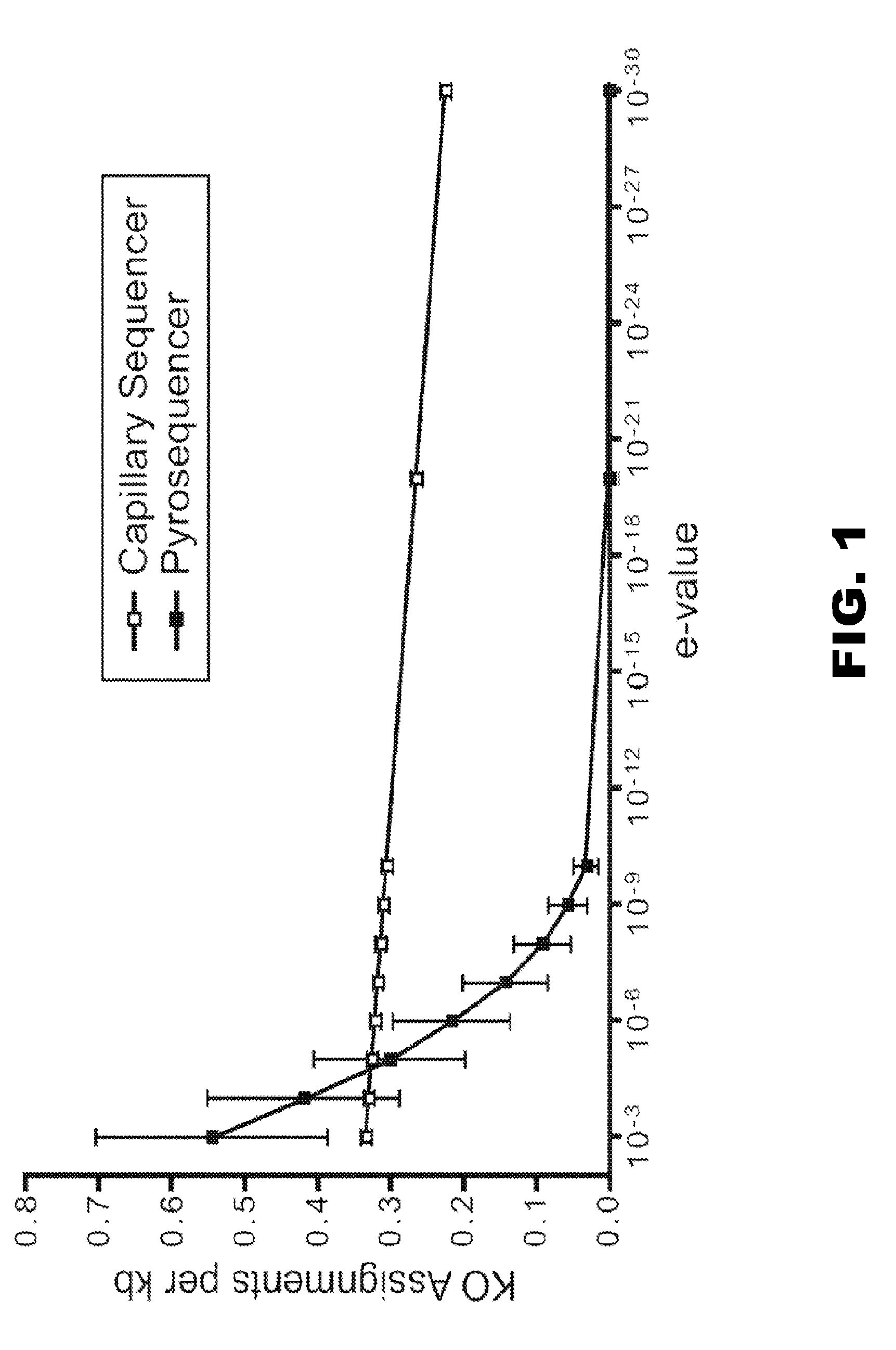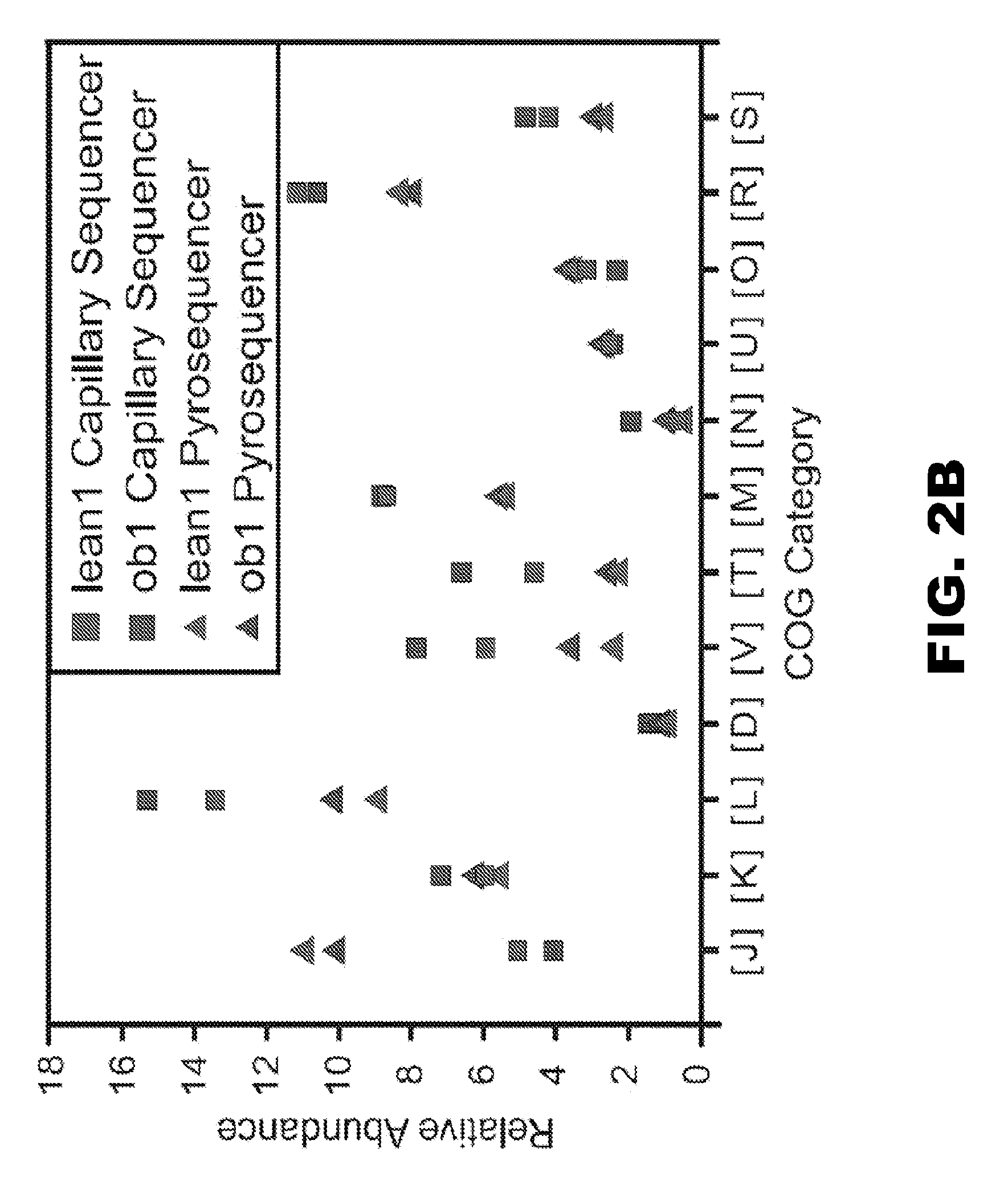Gut microbiome as a biomarker and therapeutic target for treating obesity or an obesity related disorder
a technology of the gut microbiome and obesity, applied in the field of gut microbiome, can solve the problems of increasing the prevalence of obesity at alarming rates, various types of surgeries have relatively high morbidity and mortality rates, and dieting is not an adequate long-term solution for most people, so as to reduce body fat, promote weight loss, and reduce energy harvesting
- Summary
- Abstract
- Description
- Claims
- Application Information
AI Technical Summary
Benefits of technology
Problems solved by technology
Method used
Image
Examples
example 1
Shotgun Sequencing of Microbiomes
[0116]To determine if microbial community gene content correlates with, and is a potential contributing factor to obesity, we characterized the distal gut microbiome of adult C57BL / 6J mice homozygous for a mutation in the leptin gene (ob) that produces obesity, as well as the microbiomes of their lean (ob / + and + / +) littermates by random shotgun sequencing of their cecal microbial DNA. Mice were used for these comparative metagenomics studies to eliminate many of the confounding variables (environment, diet, and genotype) that would make such a proof-of-principle experiment more difficult to perform and interpret in humans. The cecum was chosen as the gut habitat for sampling because it is an anatomically distinct structure, located between the distal small intestine and colon that is colonized with sufficient quantities of a readily harvested microbiota for metagenomic analysis.
[0117]Animals. All experiments involving mice were performed using proto...
example 2
Taxonomic Analysis of Microbiomes
[0123]Database search parameters NCBI BLAST was used to query the nonredundant database (NR), the STRING-extended COG database (179 microbial genomes, version 6.3) (von Mering et al. (2005) Nucl. Acids Res. 33:D433-437), a database constructed from 334 genomes available through KEGG (version 37) (Kanehisa et al. (2004) Nucl. Acids Res 32: D277-280), and the Ribosomal Database Project database (RDP, version 9.33) (Cole et al. (2005) Nucl. Acids Res33:D294-296). Reads with multiple COG / KO hits were counted once for each classification scheme. KO hits were also categorized into CAZy families (http: / / afmb.cnrs-mrs.fr / CAZY / ). KEGG pathway maps are available on-line (http: / / gordonlab.wustl.edu / supplemental / Turnbaugh / obob / ). NR, COG, and KEGG comparisons were performed using NCBI BLASTX. RDP comparisons were performed using NCBI BLASTN, and microbiomes were directly compared using TBLASTX. A cutoff of e-value −5 was used for EGT assignments and sequence com...
example 3
Comparative Metagenomic Analysis
[0129]Clustering of microbiomes based on predicted metabolic function Microbiomes were clustered based on the percent representation of EGTs assigned to each COG, KEGG pathway, and phylotype (genome in NR) using Cluster3.0. Percent representation was calculated as the number of EGTs assigned to a given group divided by the number of EGTs assigned to all groups. Single linkage hiearchical clustering via Pearson's correlation was performed on each dataset, and the results were visualized by using the Treeview Java applet (Saldanha (2004) Bioinformatics 20:3246-3248). Principal Component Analysis was also performed based on the percent representation of EGTs assigned to KEGG pathways (Cluster3.0) (Dailey et al. (1987) J. Bacteriol. 169:917-919), and the data were graphed according to the first two coordinates.
[0130]Identification of statistically enriched and depleted metabolic groups Two methods were used to determine statistically enriched or depleted ...
PUM
 Login to View More
Login to View More Abstract
Description
Claims
Application Information
 Login to View More
Login to View More - R&D
- Intellectual Property
- Life Sciences
- Materials
- Tech Scout
- Unparalleled Data Quality
- Higher Quality Content
- 60% Fewer Hallucinations
Browse by: Latest US Patents, China's latest patents, Technical Efficacy Thesaurus, Application Domain, Technology Topic, Popular Technical Reports.
© 2025 PatSnap. All rights reserved.Legal|Privacy policy|Modern Slavery Act Transparency Statement|Sitemap|About US| Contact US: help@patsnap.com



